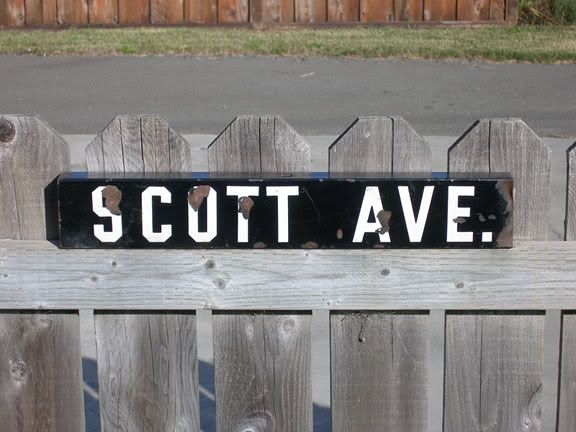Quote:
Originally Posted by Los Angeles Past

I've got an original old L.A. street sign of the exact style shown in this pic, and I've always wondered just exactly how old it is:

BTW, I didn't buy this anywhere, I stole it myself when I was a teenager in the early 1970s. 
-Scott |
Hehe! Well, I've seen LA street signs in that style from old photos that date from the late 1920s, so, your sign could be as old as that.
A few years ago, the LA Department of Transportation website used to include a link called "Topics and Tales," or something like that, and it totally talked about old Los Angeles street signs and street lights. It also talked about early freeways of the Los Angeles area, with some interesting pictures. I went onto the LADOT website recently and apparently the Topics and Tales link no longer exists.
Here's an undated photo from the LAPL, of street signs in that same style:

Notice the directional sign for Occidental College, created by the Auto Club of Southern California. I learned some years ago that basically for nearly the first half of the 20th Century, the Auto Club of SoCal used to create all road signs, directional, speed limit, city limit signs, etc., before the California Department of Transportation took over. I found it interesting that a private group would create road signs. Some of these still exist here and there, as recently as a few months ago, even in my town of South Pasadena, there's an old road sign and at the very bottom you see a small logo of the Auto Club of Southern California. I should take a picture of it before it gets replaced, if it hasn't been already.
Those metal "gun" signs that still exist in LA date from the late 1940s:
 USC digital archive, photo from 1959
USC digital archive, photo from 1959
Notice the finial on top of the pole. Some of those still exist here and there in LA.
When I first started looking at old photos of Wilshire Blvd. with the Wilshire Special street lights, I noticed the street signs too; you only see that style on Wilshire Blvd. and only on those lamp posts, I figure maybe they were meant only for the stretch of Wilshire with the custom-made street lights, as in the photo I posted earlier:
 USC digital archive
USC digital archive
I guess when the LA DOT introduced the gun-shaped street signs (which I as a kid loved and still do, and even when I was a kid they reminded me of guns), they installed them on Wilshire but didn't remove the older signs for some reason and kept them for a while, as you can see in this photo from 1948:
 USC digital archive
USC digital archive
The current mounting of LA street signs is kind of unique, IMO. In that Topics and Tales link in the LA DOT website, it mentioned that LA street signs are now mounted on the near right-hand side of an intersection, with a single sign at each corner. It gives no reason for why they're mounted this way. The Topics ad Tales link also mentioned overhead mounted traffic lights in Los Angeles. In California, span-wire mounted traffic lights were never popular for some reason, but they were used here and there in LA; California had traffic lights mounted on poles at the corners of intersections, but on busy, wide streets these can be hard to see if a driver is stopped far from the intersection, so at some key intersections, overhead span-wire mounted traffic lights were used. These later evolved into the traffic lights mounted on mast-arms that have become common throughout California.
Here's the intersection of Wilshire and La Brea in 1940, showing a traffic light suspended on a span wire:
 USC digital archive
USC digital archive
LA also pioneered the use of large approach signs which makes it easier for drivers to read, which later evolved into the large street signs you see at traffic-light controlled intersections, which other cities in other parts of the US have also adopted.
From 1960; notice the large Olympic Blvd. sign (and the cool 1959 Chevy with the gull-wing tailfins):
 USC digital archive
USC digital archive